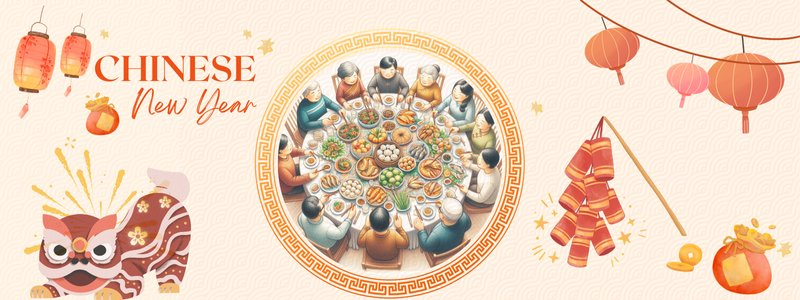过年 guònián (Chinese New Year) is the most important traditional festival in China, celebrated by Chinese communities worldwide. The festival lasts for 5-9 days, depending on which day of the week it starts.
People celebrate by reuniting with family, having big feasts, giving red envelopes (红包 hóngbāo), and setting off firecrackers. Each year is associated with one of the 12 Chinese zodiac animals, influencing traditions and beliefs. The holiday symbolizes new beginnings, prosperity, and good fortune for the year ahead.
Chinese New Year = Lunar New Year?
Not exactly! While 农历 nónglì is often translated as the “Lunar Calendar,” a more accurate term would be the “Chinese Lunisolar Calendar” or “Chinese Agricultural Calendar.”
A Lunar Calendar is any calendar system based purely on the moon’s cycles, where months follow the moon phases. Many cultures have their own versions, like the Islamic Hijri calendar, which is strictly lunar. However, nónglì is actually a lunisolar calendar, meaning it’s based on both the moon’s phases (lunar) and the solar year (solar). This system considers both the moon and the sun’s positions, which is why it differs from a purely lunar calendar.
I know that Korea and Vietnam also celebrate the Lunar New Year, so to me, saying “Happy Chinese New Year” or “Happy Lunar New Year” both make sense. But if I’m in China or Taiwan, or if I’m greeting someone Chinese, I naturally prefer “Happy Chinese New Year.” It’s like how Korea calls it Seollal, Vietnam calls it Tết, and Mongolia calls it Tsagaan Sar. I wouldn’t go and tell them, “Hey, you should call it Lunar New Year Day!” But if I’m greeting people from different countries, “Happy Lunar New Year” might be a more inclusive choice.
When is 过年 guònián?
| Day (How Chinese call it) | Date in Chinese Agricultural Calendar | Traditions & Activities |
|---|---|---|
| Dec 20-30 | ✓ Cleaning your house ✓ Paste spring couplets ✓ Buy new clothes | |
| Chinese New Year’s Eve (除夕 chúxì) | Dec 30 | ✓ Family reunion dinner ✓ Giving red envelopes ✓ Staying up late ✓ Watching New Year’s TV shows ✓ Lighting lights ✓ Offering prayers to ancestors ✓ Set off firecrackers |
| Day 1 (初一 chūyī) | Jan 1 | ✓ Visiting relatives and saying New Year’s greetings ✓ Wearing new clothes ✓ Giving red envelopes ✓ Avoiding cleaning, using knife, and taking medicine. |
| Day 2 (初二 chūèr) | Jan 2 | ✓ Married daughters visit their parents ✓ Giving red envelopes ✓ Offering prayers to ancestors |
| Day 3 (初三 chūsān) | Jan 3 | ✓ Sleeping longer or going to bed earlier ✓ “Red Mouth Day” (赤口) – a day believed to bring arguments, so many people avoid visiting others. |
| Day 4 (初四 chūsì) | Jan 4 | ✓ Preparing for the welcoming of the God of Wealth |
| Day 5 (初五 chūwǔ) | Jan 5 | ✓ Businesses fully reopen ✓ Set off firecrackers to drive away bad luck ✓ Offering prayers to God of Sky |
What Do We Do During 過年 guònián
- Family reunion dinner
年夜饭 niányè fàn
It also known as 团圆饭 (tuányuán fàn), is the most significant family dinner in Chinese culture, traditionally held on Chinese New Year’s Eve. This feast represents family reunion, gratitude to ancestors, and hopes for prosperity in the coming year. Every dish served carries symbolic meaning. In modern times, while some families maintain the tradition of home cooking, others may celebrate in restaurants or connect with distant family members via video calls.
- Giving red envelopes
红包 hóngbāo & 压岁钱 yāsuì qián
压岁钱 yāsuìqián is a traditional Chinese monetary gift, usually given in 红 hóngbāo (red envelopes). While hóngbāo can be given throughout the year for occasions like weddings, birthdays, or achievements, yāsuìqián is specifically for Chinese New Year.
The money yāsuì qián literally means “money to push away age.” When children are young, parents give them yāsuì qián, hoping they will stay young and always be their little ones. But as the children grow up, they start giving yāsuì qián to their parents instead, wishing for them to stay healthy, never grow old, and always be by their side.
- Staying up late
守岁 shǒusuì
On Chinese New Year’s Eve, people stay up late or even all night to welcome the new year. This tradition symbolizes hope for a fresh start, leaving behind bad luck and embracing peace and prosperity. 守岁 shǒusuì carries different meanings. For the elderly, it’s a way to cherish time and reflect on the past year, while for the younger generation, it’s a way to wish their parents a long and healthy life.
- Welcoming of the God of Wealth
迎財神 yíng cáishén
The 5th day of the Chinese New Year is traditionally believed to be the God of Wealth’s birthday. To attract prosperity, people begin preparations at midnight on the fourth day, setting up offerings like cakes, fruits, meats, and incense. With drums, firecrackers, and prayers, they enthusiastically welcome the God of Wealth, hoping for a year of good fortune and success.
- Watching New Year’s TV shows
看春晚 kàn chūnwǎn (China Only)
春晚 Chūnwǎn is an annual TV variety show broadcast by China Central Television (CCTV) on Chinese New Year’s Eve. It is one of the most-watched television programs in the world, as families across China and beyond gather to enjoy the show while celebrating Chinese New Year’s Eve together.
Food for 过年 guònián
Stories related to 过年 guònián
- 年獸 niánshòu
This story explains why we need to set off firecrackers, wearing red, paste spring couplets, and saying congratulations.
- 老鼠嫁女儿 lǎoshǔ jià nǚ‘ér
This is why we need to sleep longer or go to bed earlier on the 3rd day of the New Year.


